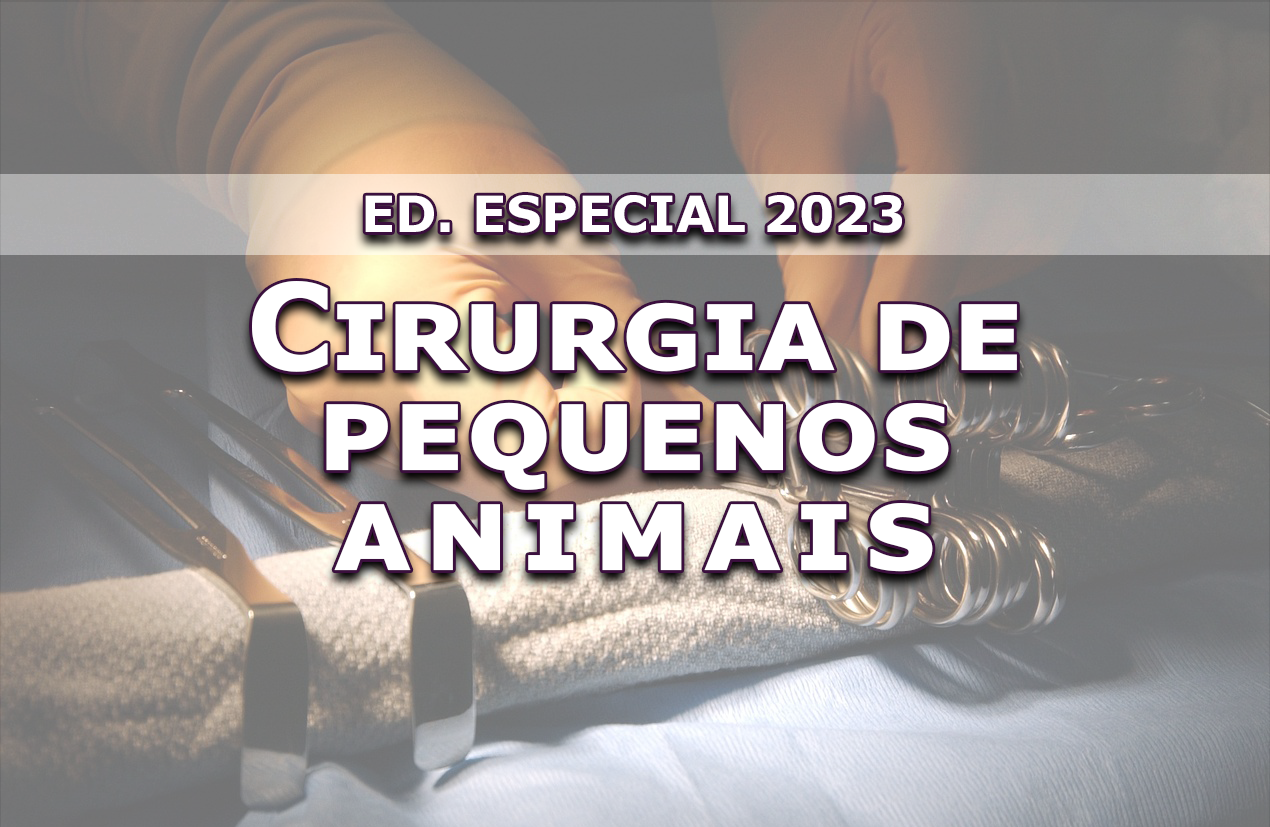Bilateral total mandibulectomy in a dog with ameloblastoma: Case Report
DOI:
https://doi.org/10.31533/pubvet.v17n13e1520Keywords:
Oncologic surgery, jaw, oral neoplasm, odontogenicAbstract
Ameloblastoma is the most common among all oral cavity neoplasms. It is benign and happens because of a genetic malfunction of the cells responsible for the enamel, called ameloblasts. These tumors may occur in any place of the oral cavity, and often present quick growth. Surgery is the main course of treatment, seeking full tumor excision. Surgery may be associated with chemotherapy or radiation. This paper aims to report a case of bilateral total mandibulectomy of a patient with ameloblastoma. The patient had no previous medical history and had a large jaw tumor that caused sialorrhea with blood streaks, cachexia, problems with mouth occlusion, pain and anemia. Left total mandibulectomy was the first-choice treatment, but a right partial mandibulectomy was needed afterwards. However, 2 other reinterventions were necessary, which led to total bilateral mandibulectomy. In conclusion the chosen procedure was effective in bringing quality of life and well-being to the patient.
References
Becelli, R., Morello, R., Renzi, G., Matarazzo, G., & Dominici, C. (2011). Treatment of recurrent mandibular ameloblastoma with segmental resection and revascularized fibula free flap. Journal of Craniofacial Surgery, 22(3), 1163–1165. https://doi.org/10.1097/SCS.0b013e318210bc34.
Chamberlain, T. P., & Lommer, M. J. (2012). Clinical behavior of odontogenic tumors. In Oral and maxillofacial surgery in dogs and cats (pp. 403–410). Elsevier Saunders. https://doi.org/10.1016/B978-0-7020-4618-6.00041-5.
Corrêa, A. P. S., Brust, A. W. A., & Jesus, G. P. (2010). Prototipagem rápida: um método auxiliar no tratamento de ameloblastoma: Relato de caso. Revista Odontolagia UNESP, 39(4), 247–254.
Daleck, C. R., Fonseca, C. S., & Canola, J. C. (2016). Oncologia em cães e gatos. Roca.
Dias, F. G. G., Pereira, L. F., Dias, L. G. G. G., Nardi, A. B., & Honsho, C. S. (2011). Epúlide acantomatoso em cão: Relato de caso. MEDVEP - Revista Científica de Medicina Veterinária, 11, 426–430.
Felizzola, C. R., Stopiglia, A. J., & Araújo, N. S. (1999). Oral tumors in dogs: clinical aspects, exfoliative cytology and histopathology. Ciência Rural, 29(3), 499–506. https://doi.org/10.1590/s0103-84781999000300020.
Fernandes, A. M. (2019). Incisivectomia no tratamento de cães em estádio I com ameloblastoma acantomatoso. Universidade Federal do Rio Grande do Sul.
Ferro, M. C. (2014). Custo-benefício dos exames anatomopatológicos, citológicos e de imuno-histoquímica em um hospital geral. Revista Da Faculdade de Ciências Médicas de Sorocaba, 16(3), 125–129.
Filgueira, K. D. (2017). Ameloblastoma acantomatoso canino: Aspecto clínico diagnóstico e manejo terapêutico. Revista de Cães e Gatos, 33(212), 58–59.
Goldschmidt, S. L., Bell, C. M., Hetzel, S., & Soukup, J. (2017). Clinical characterization of canine acanthomatous ameloblastoma (CAA) in 263 dogs and the influence of postsurgical histopathological margin on local recurrence. Journal of Veterinary Dentistry, 34(4), 241–247. https://doi.org/0.1177/0898756417734312.
GomesJúnior, D. C., Costa Neto, J. M., Silva, A. E., Martins Filho, E. F., Carneiro, R. L., Moraes, V. J., Ribeiro, L. R., & Silva, W. M. (2013). Ameloblastoma mandibular rostral em um cão. Semina: Ciências Agrárias, 34(1), 347–353. https://doi.org/10.5433/1679-0359.2013v34n1p347.
Gürel, A., Sennazli, G., Ozer, K., & Gulcubuk, A. (2003). Maxillary ameloblastoma case of a dog. Journal of Veterinary Science, 4(1), 79–82. https://doi.org/10.4142/jvs.2003.4.1.79.
Harvey, H. J. (1985). Oral tumors. Veterinary Clinics of North America: Small Animal Practice, 15(3), 493–500. https://doi.org/10.1016/s0195-5616(85)50052-2.
Henriques, Á. C. G., Cazal, C., Fonsêca, D. D. D., Bello, D. M. A., Araújo, N. C., & Castro, J. F. L. (2009). Considerações sobre a classificação e o comportamento biológico dos tumores odontogênicos epiteliais: revisão da literatura. Revista Brasileira de Cancerologia, 55(2), 175–184. https://doi.org/10.32635/2176-9745.rbc.2009v55n2.1649.
Liptak, J. M., Lascelles, B. D., & Duncan, X. (2012). Oral tumors. In S. T. Kuding (Ed.), Veterinary surgical oncology (pp. 119–177). Ames, Wiley-Blackwell. https://doi.org/ 10.1002/9781118729038.ch6.
Pimenta, P. S. C. (2012). P53 e o Câncer: Revisão da Literatura. In Seminário (pp. 1–38). Universidade Federal de Goiás.
Pippi, N. L., & Gomes, C. (2016). Neoplasias da cavidade oral. In C. R. Dalleck & A. B. Nardi (Eds.), Oncologia em cães e gatos (pp. 386–396). Roca, São Paulo.
Quiroga, Á. L., Silva, M. G., & Ercoli, M. T. (2016). Ameloblastoma acantomatoso em um cachorro: Relato de caso. Medicina Veterinaria y Zootecnia, 11(1), 110–115.
Santos, I. F. C., Cardoso, J. M. M., Bambo, O., & Oliveira, K. C. (2013). Hemi-maxilectomia no tratamento de fibroma oral em cão: Caso clínico. Revista Lusófona de Ciência e Medicina Veterinária, 6.
Downloads
Published
Issue
Section
License
Copyright (c) 2023 Paula Marcela Wiatek Zabandzala, Anna Carolina Foltran Julio, Emily Cristine Miglioretto Sabunas, Tayse Cristina Hornig, Thayana Neiva de Lima Queiroz

This work is licensed under a Creative Commons Attribution 4.0 International License.
Você tem o direito de:
Compartilhar — copiar e redistribuir o material em qualquer suporte ou formato
Adaptar — remixar, transformar, e criar a partir do material para qualquer fim, mesmo que comercial.
O licenciante não pode revogar estes direitos desde que você respeite os termos da licença. De acordo com os termos seguintes:
Atribuição
— Você deve dar o crédito apropriado, prover um link para a licença e indicar se mudanças foram feitas. Você deve fazê-lo em qualquer circunstância razoável, mas de nenhuma maneira que sugira que o licenciante apoia você ou o seu uso. Sem restrições adicionais
— Você não pode aplicar termos jurídicos ou medidas de caráter tecnológico que restrinjam legalmente outros de fazerem algo que a licença permita.





